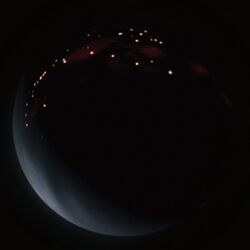Assisted Planetary Fusion Ignition (A1-0): Difference between revisions
No edit summary Tag: 2017 source edit |
No edit summary |
||
| Line 1: | Line 1: | ||
[[File:APFI.jpg|thumb| | [[File:APFI.jpg|thumb|250x250px|Krruaya undergoing early attempts of Assisted Ignition in the home star system of Kalgyul, viewed from the south hemisphere, 16,336 BBT.]] | ||
Assisted Planetary Fusion Ignition, or APFI, is the process in which a Jovian or celestial body composed mainly of hydrogen and helium, but which does not meet the mass criteria for sustained nuclear fusion, is ignited artificially through the use of low yield nuclear weapons, prompting short-lived fusion reactions within its atmosphere. | Assisted Planetary Fusion Ignition, or APFI, is the process in which a Jovian or celestial body composed mainly of hydrogen and helium, but which does not meet the mass criteria for sustained nuclear fusion, is ignited artificially through the use of low yield nuclear weapons, prompting short-lived fusion reactions within its atmosphere. | ||
This is a rather primitive technology used for the obtention of energy from gas bodies without the use of stellification engines, typically employed by civilizations lower than the S1 level. | This is a rather primitive technology used for the obtention of energy from gas bodies without the use of stellification engines, typically employed by civilizations lower than the S1 level. | ||
== Background == | |||
=== Mechanism === | |||
[[File:Binding energy curve - common isotopes-tr.svg|left|thumb|Binding energy for different atomic nuclei.]] | |||
Nuclear fusion produces when two atoms nuclei get close enough for enough time for the nuclear force that pushes them together surpasses the electrostatic forces keeping them together, resulting in them fusing into heavier nuclei. Due to hydrogen having the lightest atom of them all, consisting of a single proton, it's the easiest element to fuse, and has the highest energy output attainable. | |||
The electrostatic force that keeps the nuclei apart has a longer range than the strong force, which has the range equivalent to the diameter of a proton. This results in the atoms needing a set quantity of kinetic energy to approach close enough for the strong force to take a toll and for the nuclei to fuse. This energy requirement is known as the "Coulomb barrier", which can be broken by heating up the atoms enough, or accelerating them enough in a particle accelerator, which effectively provides the nuclei with the kinetic energy required. | |||
Revision as of 17:59, 5 August 2023

Assisted Planetary Fusion Ignition, or APFI, is the process in which a Jovian or celestial body composed mainly of hydrogen and helium, but which does not meet the mass criteria for sustained nuclear fusion, is ignited artificially through the use of low yield nuclear weapons, prompting short-lived fusion reactions within its atmosphere.
This is a rather primitive technology used for the obtention of energy from gas bodies without the use of stellification engines, typically employed by civilizations lower than the S1 level.
Background
Mechanism

Nuclear fusion produces when two atoms nuclei get close enough for enough time for the nuclear force that pushes them together surpasses the electrostatic forces keeping them together, resulting in them fusing into heavier nuclei. Due to hydrogen having the lightest atom of them all, consisting of a single proton, it's the easiest element to fuse, and has the highest energy output attainable.
The electrostatic force that keeps the nuclei apart has a longer range than the strong force, which has the range equivalent to the diameter of a proton. This results in the atoms needing a set quantity of kinetic energy to approach close enough for the strong force to take a toll and for the nuclei to fuse. This energy requirement is known as the "Coulomb barrier", which can be broken by heating up the atoms enough, or accelerating them enough in a particle accelerator, which effectively provides the nuclei with the kinetic energy required.